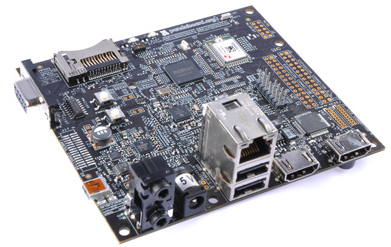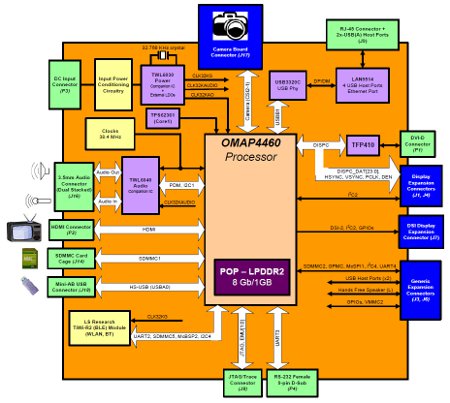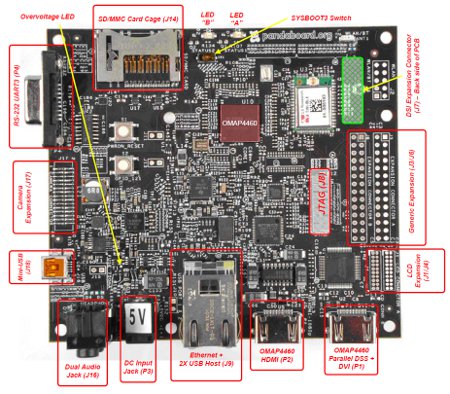Latest PandaBoard moves to 1.2GHz OMAP4460
Dec 7, 2011 — by Eric Brown — from the LinuxDevices Archive — 9 viewsPandaBoard.org is shipping a new version of its open mobile development board that advances from Texas Instruments' 1GHz dual-core, Cortex-A9-based OMAP4430 to the 1.2GHz OMAP4460. The PandaBoard ES keeps the same 4.5 x 4.0-inch dimensions, 1GB of RAM, and TI WiLink 6.0 wireless module, among other features, but adds a DSI expansion header and a new switch to control boot order.
The PandaBoard ES is software-compatible with the original PandaBoard, which was announced along with a PandaBoard.org open source community in October 2010. The board has gained a strong following in its role as the Cortex-A9 equivalent to BeagleBoard.org's Cortex-A8-based BeagleBoard-xM.
The original $179 PandaBoard prototyping and hobbyist development board, which is based on the Texas Instruments (TI) OMAP4430 system on chip (SoC), will continue to be supported, says the project. PandaBoard.org also announced that the PandaBoard is the first and only open source development tool to be supported in the Android Open Source project running Android 4.0 ("Ice Cream Sandwich"), confirming a YouTube demo of the ICS port posted in mid November.

PandaBoard ES
The PandaBoard ES moves up from TI's 1GHz OMAP4430 to the OMAP4460 SoC. Originally called the OMAP4440, the renamed SoC is capable of boosting its dual Cortex-A9 cores to 1.5GHz, although on the PandaBoard ES it is said to top out at 1.2GHz. This provides a 20 percent increase in overall performance and a 25 percent increase in graphics compared to the original, according to PandaBoard.org.

PandaBoard ES block diagram
(Click to enlarge)
Also new is Display Serial Interface (DSI) support, joining the existing HDMI and Digital Video Interface (DVI) video interfaces. Dual independent displays are supported for HDMI and DVI-D. The PandaBoard ES also debuts a SysBoot switch, "allowing for the manual switch of boot order depending on the application's need," says the project.

PandaBoard ES internal detail
(Click to enlarge)
Internal connectors include a serial UART, a camera expansion header, and a general-purpose expansion connector, says PandaBoard.org. A JTAG interface is also said to be available.
Features and specifications listed for the PandaBoard ES include:
- Processor — TI OMAP4460 (dual-core Cortex-A9 @ 1.2GHz)
- Memory — 1GB of LPDDR2 RAM
- Storage expansion — 6-in-1 SD/MMC/SDIO slot
- Display:
- HDMI 1.3
- DVI-D
- LCD expansion header supporting DSI and parallel RGB24
- simultaneous HDMI/DVI-D with independent content
- Wireless (TI WiLink 6.0 module) — 802.11b/g/n; Bluetooth 2.1 + EDR
- Networking — 10/100 Ethernet
- Other I/O:
- Mini-USB 2.0 OTG
- 4 x USB 2.0 host (2 x real-world coastline ports)
- RS-232 (via UART)
- general-purpose expansion connector
- camera expansion header
- 3.5mm stereo audio I/O
- Other features — JTAG; 2 x debug LEDs; SYSCONFIG boot order switches
- Power — 5VDC input; TI TWL6030 power companion IC
- Dimensions — 4.5 x 4.0 inches (114.3 x 101.6mm)
- Weight — 2.88 oz (81.5 g)
In its first year, more than 8,900 PandaBoard units have been sold, according to PandaBoard.org. The project boasts more than 1,000 community members working on more than 70 related projects. Nine Linux distributions have been ported to the board, says the project.
Availability
The PandaBoard ES is available now from Digi-Key for $182. More information may be found at PandaBoard.org's PandaBoard ES page.
This article was originally published on LinuxDevices.com and has been donated to the open source community by QuinStreet Inc. Please visit LinuxToday.com for up-to-date news and articles about Linux and open source.